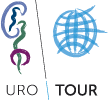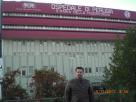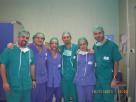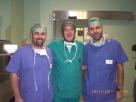Center of Excellence: Department of Urology and Andrology, University of Perugia
City: Perugia, Italy
Director/ Urotour Coordinator: Prof. Massimo Porena
Secretariat/ Organizational support: Mrs Donatella Orcidi
Visit Dates: 06-13/11/2011
Trainees: Κartsaklis Panayotis (Zakynthos)
Toutziaris Chrisovalantis (Thessaloniki)
What the trainees said
Evaluation of the Center
Together with a distinguished colleague from ThessalIoniki and within the context of UROTOUR 2011, we had the opportunity to visit the Department of Urology of Perugia University, which is accommodated in the modern Hospital of Ospedale di Perugia, Santa Maria della Misericordia. Our welcoming was warm thanks to the Italian colleagues' Mediterranean temperament and the substantial contribution of lovely Donatella, Secretary of the Department, who knew Greek. During our stay, we participated in the daily program of surgeries and outpatient clinics, while all staff members were willing to answer any question of ours. I would like to warmly thank all our colleagues for sharing with us their experiences, Professor Massimo Porena and Professor Elizabetta Constantini, who were both responsible for our educational program.
Description of the Center
The Department of Urology of the University of Perugia is accommodated in a new modern Hospital. The Hospital has moved away from the beautiful Medieval city but the new building has state-of-the art equipment meeting the high standards of Modern Medical Science today. The Department has 24 beds served by 8 Specialized Uroligists and 12 Residents. On the same floor of the Department are also installed the Outpatient Clinics, the Unit of Endoscopies and Extracorporeal Lithotripsy. The Outpatient Clinics operate on a daily basis covering every field of Urology under the supervision of the Specialized Urologist with the highest experience in each domain. The Department has 1 operation table every day, while one day a week there are 2 operation tables. From a surgical point of view, the staff covers the entire spectrum of Urology procedures with the use of advanced techniques. Our first contact with several members of the staff and in particular with Professor Elizabetta Constantini (the person in charge of our educational program) was in the operating theater, where we attended a laparoscopic pelvic organ prolapse repair with the use of a mesh. Then, Professor Constantini gave us a tour of the Department and Hospital premises, and introduced us to the other members of the Department. Our daily program included attending procedures (laparoscopic, oncological, reconstruction of external male genitalia, pelvic floor repair in women and HIFU in prostate cancer. In the evening we followed visits at the Outpatient Clinic, which dealt with a different field every day of the week. Lastly, I was particularly impressed by the technological equipment of the Department and the Hospital, the new technologies and applications of TeleMedicine that are available to be used by every Physician working at whichever part of the Hospital.
Description of the Center
The Urology Department of the University of Perugia is accommodated in a new building, serving the inhabitants of the wider district. The new Hospital Οspedale di Perugia, Santa Maria della Misericordia replaced the older one that used to be located at the other side of the city and whose infrastructure and facilities were not sufficient to meet the continuously increasing demand from patients and the advanced technological standards. An intranet system is used for all activities of the Department and, as a result, all laboratory and imaging examination results are at the disposal of therapist physicians and easily accesible whenever needed. Both the Department and Outpatient Clinics (Urodynamic, Andrology, Endourological) are accommodated on the first floor. The Department has 24 beds. There is also a One-day Clinic for patients who undergo an endourological intervention or some form of chemotherapy. The number of patients in the One-day Clinic amounts to 8. The Secretariat is on the 4th floor -together with Professor Porena's office- and mainly deals with and coordinates the academic profile of the Department (students - visitors). The Physicians' offices are located at the basement of the building. The Department has one surgical table every day, and two every Thursday. The range of surgical procedures is very wide and there is specialized medical staff dealing with a different field of Urology. There are 6 Specialized Urologists and 12 Urology Residents. As for Endourological cases, these are undertaken by a Specialized Urologist on a daily basis. In the Endourology Clinic, there is a portable Lithotripter, UltraSound system and C-Arm Fluoroscopy system. It is here that ureteric catheters and nephrostomies are placed and lithiasis patients are operated, if necessary. Cystoscopies with flexible cystoscope are performed twice a week. The Andrology Clinic operates once a week (every Monday), where -if necessary- Ultrasound and Doppler screening are conducted before and after the infusion of vasoactive agents. Patients with testicular cancer are also monitored and given instructions. The Urodynamic and Gynaecological Clinic is particularly developed and internationally renowned with pioneering published work. The Head of this Clinic is Professor Elizabetta Constantini, who mainly deals with pelvic organ prolapse repair with or without uterus preservation, according to indications. The approach is either laparoscopic or open, and a mesh is placed according to the case (anterior and posterior). Prostate biopsies are performed guided by transrectal ultrasound. Surgical equipment meets the needs of the wide range of surgical procedures that are carried out. It is worth mentioning the HIFU device for the treatment of prostate cancer. Our program included daily attendance of surgical activities and the Outpatient Clinic in the evening. Every Monday there is a meeting and discussion of cases among different specialties. The discussion is not carried out in English, as happens in Departments of the same calibre in Northern Europe. Something else I would like to point out is that -unlike other countries- there is no "team spirit" among Physicians when treating patients. Urologists there treat cases more holistically. Each Physician evaluates a case on his/her own, identifies indications for [let us say as a random example] hysterectomy in prolapse cases, sets the diagnosis, decides on the treatment. They treat on their own inguinal hernias, renal vein thrombosis and skin defect plastic reconstruction with the use of skin flap. And I left this comment for last. As a Southern European country, there are surely more similarities to the Greek reality than to other European countries. Residents have the greatest problem because they have no log book and lack practical training. Out of discussions we had with them, their dissappointment on this issue was more than obvious.
Evaluation of the Center
Our welcoming to the Department of Urology and Andrology of the University of Perugia was exceptional. I would particularly like to thank Associate Professor Elizabetta Constantini, who was responsible for our program. Friendly and open to questions, she was always there to coordinate and arrange both our scientific and social program. The overall staff of the Department were more than willing to help us and make us feel at home. As for our linguistic communication with the Secretariat, we were lucky because one of the two secretaries spoke Greek, as her husband was Greek. She really helped us significantly both in our meetings with the Professor and in shopping local traditional products. It was a perfect experience.





